Vol 2 No. 32 TROPIC LIGHTNING NEWS Aug 14, 1967
Index
| Unit Page | Unit Page | Unit Page | Unit Page |
| 1/5 3 | 2/14 6 | 25th Inf Photo 8 | 3/13 Arty 7 |
| 1/5 8 | 2/22 1 | 25th DivArty 7 | 3/13 Arty Photo 7 |
| 1/27 Photo 8 | 2/35 3 | 25th Arty Photos 7 | 3/22 1 |
| 1/35 3 | 2/35 6 | 25th S&T 6 | 3/22 3 |
| 1/35 3 | 2/35 Photo 6 | 25th S&T 6 | 4/9 Photo 1 |
| 1/35 6 | 2/77 Arty 1 | 3rd Bde 1 | 4/9 3 |
| 2/12 1 | 25th Inf 1 | 3rd Bde 8 | 4/9 6 |
| 2/14 Photo 3 | 25th Inf 1 |
NEW DIV CG
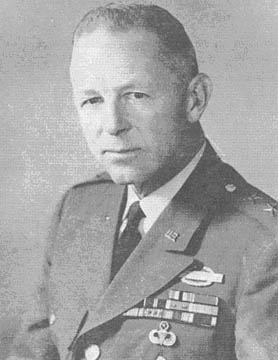 Mearns Arrives. Tillson Leaves
Mearns Arrives. Tillson Leaves
MG F. K. Mearns became the new 25th Inf Div commanding general
during a change of command ceremony at Cu Chi base camp on Aug. 6. He
succeeds MG John C.F. Tillson III who has returned to the U.S. to take command
of the First U.S. Army, Fort George G. Meade, Md.
The ceremony took place in front of division headquarters.
MG Mearns comes to the 25th from assignment as director of enlisted
personnel, Office, Chief of Personnel Operations, Washington, D.C.
He is a 1938 graduate of the U.S. Military Academy, West Point,
N.Y. Prior to World War II he served with various field artillery units at Fort
Sill, Okla., Fort Sam Houston, Tex., and Fort Lewis, Wash.
Shortly after the United States entered the Second World War, GEN
Mearns was transferred to the III Army Corps and served as assistant G-3.
He then served in the same capacity with the VI Army Corps. In November
1943, he became battalion commander of the 3d Bn, 135th Inf. The general
participated in the Sicilian, Naples-Foggia, and Rome-Arno Campaigns.
Following World War II GEN Mearns spent nearly four years at
Columbia University and in Europe studying the Russian language and the Soviet
geographical area. He then served as plans officer and G-3 of U.S. Forces
in Austria; in the latter capacity as U.S. representative on the quadropartite
Military Committee in Vienna.
Returning to the U.S. in 1950 and following attendance at the
Artillery and Guided Missile School, he commanded successively the 75th Arty Bn,
17th Arty Gp, and 77th Arty Gp.
Upon graduation in 1952 from the Armed Forces Staff College at
Norfolk, Va., GEN Mearns became the first director, Special Forces Department of
the Unconventional Warfare School at Fort Bragg, N.C.
In 1954 he was appointed U.S. Army Attache to the USSR and served
in that position in Moscow until 1957. Upon return to the U.S. he attended
the Army War College, graduating in 1958. Thereafter he served two years
as G-3, Sixth U.S. Army in San Francisco.
Upon return to Fort Bragg in 1960 and assignment to the 82d
Airborne Div., he commanded the Div Arty of that organization and then served as
its chief of staff in 1961-62.
In November 1962, GEN Mearns became artillery commander, XVIII
Airborne Corps at Fort Bragg. He was reassigned to U.S. Army Europe in
June 1963, as artillery commander, 3d Armored Div. One year later, June
1964, he became artillery commander, V Corps.
He and his wife, the former Elizabeth M. Boles, have three
children, Nancy E. (married), Suzanne, 23, and Robert K., 21.
General Johnson Visits 25th Camp
Chief of Staff of the Army GEN Harold K. Johnson made a three-hour
tour of 25th Inf Div units Aug. 3 during his eighth visit to Vietnam. GEN
Johnson was here to gain first hand knowledge of the current situation.
The chief of staff was met upon his arrival at the 5th ARVN Div by
MG John C.F. Tillson III, then 25th Div CG.
He then traveled to 25th Div Hq at Cu Chi where he received a
briefing on operations now in progress within the 25th's area of
responsibility.
During his brief stay he also visited the 4th Bn, 23d Inf; 4th Bn,
9th Inf; and 1st Bn, 5th Inf.
Accompanying the general on his tour were LTC J. C. Kiefe,
executive assistant to GEN Johnson, and SGM W. O. Woolridge, sergeant major of the
Army.
GEN Johnson took over as chief of staff of the Army in July 1964.
Prior to then he served as assistant deputy chief of staff for military
operations for Plans and Operations, Department of the Army.
He is a survivor of the Bataan death march of World War II fame,
and was liberated three years later when the 7th Div made their occupational
landing at Inchon, Korea.
3d Bde, 4th Inf Now 3/25th
DAU TIENG - After being under the operational control of the 25th
Inf Div for more than nine months, the 3rd Bde, 4th Div is now carrying the
Tropic Lightning name, as the 3rd Bde, 25th Inf Div.
Prior to coming to Vietnam, most of the men of the 3rd Bde were raw
recruits, just drafted into the Army. They were sent to Fort Lewis, Wash. where
they received basic and advanced individual training. Twenty-two hundred
draftees in December 1965 became the core of the fledgling brigade.
In Vietnam, the training continued as the brigade first sent out
small unit patrols around the Bear Cat base camp. This progressed into
company-sized operations, and then to the first multi-battalion operation
"Bremerton."
Designed to clear Viet Cong out of the Rung Sat Special Zone and
also to promote the revolutionary development program in that area, the 3rd Bn,
22nd Inf and Btry C, 2nd Bn, 77th Arty continued their search and destroy
mission in the Rung Sat while the rest of the brigade moved the base camp to its
present location at Dau Tieng.
Since the brigade's arrival at Camp Rainier, November 1966, it
has been under the control of the 25th Inf Div in such combat operations as
"Attleboro, Cedar Falls, Gadsden, Junction City, Ahina," and
"Diamondhead." These operations covered large sections of the dense
jungle and swampy marshland of War Zone C.
In a single engagement during Operation Junction City, the 3rd Bde
decimated the Viet Cong's 272nd Regiment in hand-to-hand fighting at a small
fire support base 35 kms northeast of Tay Ninh. When the four-hour battle
was over, 647 Viet Cong regulars had lost their lives.
The brigade is now responsible for the majority of War Zone C
including the Tay Ninh and Dau Tieng base camps and the large expanse of dense
jungle north and west of Dau Tieng to the Cambodian border.
The 3rd Bde is commanded by COL Kenneth E. Buell and consists of
three infantry battalions and one artillery battalion. The 3rd Spt Bn
provides logistical support for the large brigade.
The 2nd Bn (Mech), 22nd Inf. commanded by LTC Ralph W. Julian
provides the mechanized punch for the brigade operations while the two other
infantry battalions, the 2nd Bn, 12th Inf, and the 3rd Bn, 22nd Inf, scour the
jungles with the thoroughness only the man who is walking, and at times,
crawling through the jungle can achieve. The 2/12 "White Warriors" are
commanded by LTC James F. Greer, while LTC James E. Hilmar leads the 3/22
"Regulars."
Artillery supporting fires are provided by the 2nd Bn, 77th
Arty which is commanded by LTC Fred J. Merritt.
The main base camp of the 3rd Bde is located in the heart of the
Michelin Rubber Plantation.
| MOBILE MORTAR POSITION - Infantrymen from the 4th Bn, 9th Inf, have mechanized their 81mm mortars by mounting them on the back of three-quarter ton trucks using sandbags and scrap lumber. The mobile positions have proven effective in 25th Div operations. (Photo by SP4 Carlos Webb) | 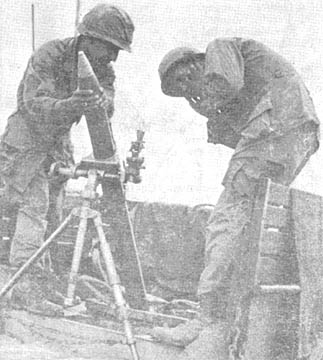 |
Page 2 TROPIC LIGHTNING NEWS Aug 14, 1967
Decorated
. . . Let us set for ourselves a standard so
high that it will be a glory to live up
to it, and then let us live up to it and
add a new laurel to the crown of America.
Woodrow Wilson
| SILVER STAR | |
|
MAJ Harold I. Small, 116th Aslt Hel Co, 269th Cbt Avn Bn CPT James E. Bristol, HHC, 2d Bn (Mech), 22d Inf CPT Clifford W. Steelman, Co C, 1st Bn, 27th Inf CPT Larry W. Garlock, Co B, 1st Bn, 27th Inf CPT James W. Shugart III, Co B, 3d Bn, 22d Inf 1LT Frederick N. Noseworthy, Co C, 2d Bn, 27th Inf 1LT William J. Wells, Co C, 2d Bn, 27th Inf |
SP4 Victor J. Padilla, Co A, 2d Bn, 27th Inf SP4 David W. Riddle, Co C, 2d Bn, 14th Inf SP4 Ralph Smith, Co C, 2d Bn, 27th Inf SP4 Emmett A. Hollis, Co C, 2d Bn, 27th Inf SP4 Robert F. Hayes, A Btry, 2d Bn, 77th Arty PFC Lloyd A. Beesley, Co C, 65th Engr Bn PFC William W. Bednarz, Co C, 2d Bn, 27th Inf |
DISTINGUISHED FLYING CROSS |
|
|
MAJ Harold I. Small, 116th Aslt Hel Co, 269th Cbt Avn Bn MAJ Charles A. Morris, Co E, 725th Maint Bn CPT John C. Phillips Jr., HHC WO1 John M. Hohman, D Trp, 3d Sqdn, 4th Cav WO1 Ronald L. Darr, 254th Med Det |
WO1 Homer C. Rogers, 128th Aslt Hel Co SP4 Charles E. Kirkpatrick, 173d Aslt Hel Co SP4 Juan A. Vargas, D Trp, 3d Sqdn, 4th Cav PFC Robert T. Jordon, 173d Aslt Hel Co |
BRONZE STAR (VALOR) |
|
|
CPT John W. Byers, Co A, 2d Bn, 14th Inf CPT Michael V. Gibert, Hq & Svc Btry, 2d Bn, 77th Arty CPT Freeman F. Glover, HHC, 3d Bn, 22d Inf CPT Brian A. Loy, HHB, 1st Bn, 8th Arty CPT Thomas A. Brewer, 2d Bn, 27th Inf 1LT Joseph F. Hayes, Co B, 3d Bn, 22d Inf 1LT Claude D. Ellison Jr., C Btry, 2d Bn, 77th Arty WO1 Michael R. Banks, D Trp, 3d Sqdn, 4th Cav MSG L. G. Rogers, Hq & Svc Btry, 2d Bn, 77th Arty SFC Charley R. Hurt, Co B, 1st Bn (Mech), 5th Inf PSG Jose F. Blancaflor, Co C, 3d Bn, 22d Inf SSG Jorge Suarez-Quinones, Co B, 2d Bn, 14th Inf SSG John Roberson, HHC, 1st Bn (Mech), 5th Inf SGT Walter H. Gardner, C Btry, 2d Bn, 77th Arty SGT Donald C. Wilson, Co A, 3d Bn, 22d Inf SP5 Stephan Franc, HHC, 2d Bn, 12th Inf SP5 Walter T. Yewdell, H&H Btry, 2d Bn, 77th Arty, |
CPL Peter T. Montagliano, A Btry, 2d Bn, 77th Arty SP4 Geofrey Landerkin, A Trp, 3d Sqdn, 4th Cav SP4 Morris L. Johansen, Co C, 2d Bn (Mech), 22d Inf SP4 Herbert E. Webb, Co C, 2d Bn, 27th Inf SP4 Albert Van Deusen, Co C, 1st Bn, 27th Inf SP4 Ray Curry Jr., Co C, 2d Bn, 27th Inf SP4 James P. Carter, Co A, 3d Bn, 22d Inf SP4 James G. Cook Jr., A Btry, 2d Bn, 77th Arty SP4 Tommy R. Peters, Co B, 2d Bn, 14th Inf SP4 Kenneth R. Blevins, Co B, 2d Bn, 14th Inf SP4 John J. Crush, D Trp, 3d Sqdn, 4th Cav SP4 Robert N. Rasmussen, Co B, 3d Bn, 22d Inf PFC Lawrence R. Osterbrink, Co A, 1st Bn (Mech), 5th Inf PFC George A. Reese Jr., Co B, 2d Bn, 14th Inf PFC Daniel E. Willoughby, Co C, 2d Bn, 27th Inf PFC Ronald J. Lewis, Co C, 2d Bn, 27th Inf |
ARMY COMMENDATION MEDAL (MERIT) |
|
|
CPT Thomas E. Fleming, D Trp, 3d Sqdn, 4th Cav MSG Samuel O. Holbrook, Co B, 2d Bn, 14th Inf SSG Benjamin Hooks Jr., Co B, 1st Bn, 27th Inf SP6 Orvin L. Stringham, D Trp, 3d Sqdn, 4th Cav SGT James E. Call, D Trp, 3d Sqdn, 4th Cav |
SP5 Roy L. Roch, Co A, 61th Engr Bn SP4 Tommie Towns, Co B, 25th Avn Bn SP4 Curtis .M. Young, D Trp, 3d Sqdn, 4th Cav SP4 Larry D. McIntosh, D Trp, 3d Sqdn, 4th Cav SP4 Benny F. Herioux, Co C, 2d Bn (Mech), 22d Inf |
WO Field Wide Open For EM
The U.S. Army is encouraging qualified individuals to apply for
military occupational specialties for which the Army has warrant officer
requirements.
DA Circular 601-13, dated 22 June 1967, lists 35 specialties for
which warrant officers are needed. The circular authorizes retired warrant
officers to apply for active duty and further provides for granting waivers of
maximum age and service limitations.
Reserve warrant officers holding any of the listed specialties may
apply for active duty. Enlisted personnel who possess the required
qualifications may apply for appointment as warrant officer (W-1) with
concurrent call to active duty.
Following is a list of the military occupational specialties for
which warrant officers are needed:
Helicopter pilot, utility and light cargo single rotor; meteorology
technician; field artillery radar technician; field artillery missile system
technician, PERSHING; field artillery missile system technician, SERGEANT; air
defense missile assembly technician, NIKE; air defense missile fire control
technician, NIKE.
Also, air defense missile system technician, HAWK; field artillery
missile system repair technician, SERGEANT; field artillery missile system
repair technician, PERSHING; air defense missile system repair technician, NIKE;
air defense missile system repair technician, HAWK; communications-electronics
repair technician; fire distribution systems repair technician; armament repair
technician.
Also, ordnance shop technician; utilities maintenance technician;
master or mate; marine engineering technician; engineer equipment repair
technician; automotive maintenance technician; automotive repair technician;
unit personnel technician.
Also, legal administrative technician; cryptographic technician;
data processing technician, EAM; unit supply technician; photomapping
technician; survey technician; map reproduction technician; food service
technician.
Resor Says
Soldiers "Can Do"
Speaking about his observations of U.S. soldiers in Vietnam,
Secretary of the Army Stanley R. Resor has said he found a prevailing
"can-do" attitude and a sense of purpose and dedication that was most
impressive.
This "can-do" attitude of U.S. Army personnel serving in
Vietnam clearly reflects a "duty-first" attitude.
In defining DUTY, Webster's Dictionary calls it "the action
required by one's position or occupation" and "a moral or legal
obligation."
But "action required" is not enough. Duty also means the
desire to do more than just the basic task, to carry a job through, to see that
every detail is complete.
No soldier should feel that the "duty-first" attitude is
limited in Vietnam. Whether serving in the United States, Europe, Korea or
anywhere the U.S. Army maintains free-world security, the extra time and effort
a soldier puts into a thorough job demonstrates the "duty-first" attitude
being shown in Vietnam.
General Harold K. Johnson, the U.S. Army Chief of Staff, has said,
"We should show our pride in our comrades there (Vietnam) by doing our tasks
with equal diligence and by standing ready to acquit ourselves as they do."
The feeling of unit pride and individual self-satisfaction gained
from a job well done is the true mark of "duty-first" soldiers.
Are you a "duty-first" soldier? (ANF)
Allotment Checks Missing?
Would you believe that about 15,800 allotment checks and bonds are
being returned to the Finance Center, U.S. Army every month because they cannot
be delivered at the addresses printed on them? This means that many
individuals (members and dependents) are failing to notify the Finance Center
when they move. Are you one of these? Since it takes quite some time
to process and remail these checks and bonds, delays in receipt can be lengthy.
When you fail to notify the FCUSA of a change of address, your
dependents could endure hardships because of late receipt of the allotment
check. Also, you may lose interest on your savings account because of late
delivery of class E allotment check for savings deposits in commercial banks.
In any case, you and your dependents should remember -- to insure timely receipt
of allotment checks and U.S. savings bonds, furnish your new address to FCUSA
immediately.
With each check or bond being sent overseas, a self-addressed
change-of-address card is included. Checks or bonds mailed within CONUS
will include the same type self-addressed change-of-address card every third
month. These cards can be used at any time to notify the Finance Center of
a new address. When there is no change-of-address card available to either
you or your dependent, a letter or post card can be sent to the Finance Center,
U.S. Army, ATTN: Allotments and Deposits Operations, Indianapolis, Ind. 46249.
New Catalog Due At PX
HONOLULU - A new offshore catalog is being developed by
Headquarters PACEX for use by Exchange customers in the Pacific. The
catalog will primarily contain some 200 high demand items of offshore origin
which have been found in the past to be popular with the troops as principally
souvenir items.
NEED SOURCES
The old offshore catalog, popularly referred to as the "JAKOR
Catalog" will be replaced by this new one as soon as sources for the items are
developed and the catalog is printed and distributed in sufficient quantities.
During the interim period orders will continue to be filled through the JAKOR
Mail Order Section from the current catalog.
DUPLICATE ITEMS
Since the new catalog is designed to duplicate items in the
Southeast Asia stock assortment, (primarily for Vietnam and Thailand) orders
from the catalog will be accepted for delivery from APOs to CONUS addresses
only.
Distributed to Customers
The new catalog will be distributed to individual customers in
Vietnam and Thailand, and will be available at most customer service counters
throughout Pacific Exchange System main outlets. In smaller Exchanges,
catalogs will be available at managers' offices.
CODE
OF CONDUCT NO. II
I will never surrender of my own free will. If in command,
I will never surrender my men while they still have the means to resist.
The TROPIC LIGHTNING NEWS is an authorized publication of the 25th Infantry Division. It is published weekly for all division units in the Republic of Vietnam by the Information Office, 25th Infantry Division, APO San Francisco 96225. Army News Features, Army Photo Features, Armed Forces Press Service and Armed Forces News Bureau material are used. Views and opinions expressed are not necessarily those of the Department of the Army. Printed in Tokyo, Japan, by Pacific Stars and Stripes.
MG F.K. Mearns . . . . . . . . . . . . . . . Commanding General
Maj. Bernard S. Rhees . . . . . . . . . . . Information Officer
1Lt. Larry Rottmann . . . . . . . . . . . . . Officer-in-Charge
SSG David G. Wilkinson . . . . . . . . . Editor-in-Chief
SP5 Terry S. Richard . . . . . . . . . . . . Editorial Assistant
PFC Dave Cushman . . . . . . . . . . . . Editorial Assistant
Page 3 TROPIC LIGHTNING NEWS Aug 14, 1967
Tunnel Rats Kill 6, Detain 5 Viet Cong
By CPT Don Morton
DUC PHO - Working with entrenching tools, a flashlight and armed
with .45 cal. pistols the "Tunnel Rats" made trip after trip into tunnels
searching for Communist guerrillas and equipment.
After a long day of digging and probing the banks of a small stream
near Duc Pho, the "Cacti" platoon had searched seven tunnels, killed six VC,
captured three weapons, five detainees and numerous hand grenades and ammo.
"We moved in here purely on an educated guess," said 1LT John
G. Denino. "We had been receiving sniper fire from this location so we
decided to make a thorough search."
Dividing into search teams, the 3rd Pltn, Co A, 2nd Bn, 35th Inf,
set about the tedious mission of hunting the entrenched enemy.
"The area was full of spider holes and tunnels," related PFC
Andrew MacGregor of Brooklyn, N.Y. "We had to search them all and many were
hard to find."
Most of the tunnels were along the banks of a small stream.
The entrances were well camouflaged behind bamboo and dense vine thickets.
The infantrymen cautiously probed each thicket looking for a path which
might give away the location of the entrance. A door made of either sticks
or boards covered by dirt and grass concealed the exact location.
It was mid-morning when MacGregor and PFC Herman E. Bowers of Mt.
Vernon, Tenn., discovered a worn path leading into a bamboo thicket. The
duo had barely started digging when they hit the sticks covering the entrance.
As one stick was removed, PFC Gearld McAfee of Tulsa, Okla., who had joined the
pair, caught a glimpse of a weapon muzzle. Rifle fire tore into the entrance
followed by grenades.
Next PFC Benjamin Chavet, a tough little soldier from Van Nuys,
Calif., and the platoon's ace tunnel rat, went to work searching out the
tunnel. Three VC were killed and three weapons captured.
However, the day was just beginning. "Keep searching, there
must be at least a squad," was the order from Denino.
The search teams once again set about the hot and tedious task.
Probing the bamboo thickets again proved fruitful as another tunnel was
discovered. Again the call went out for Chavet. Although the VC had
abandoned the tunnel, grenades and new boxes of ammo were captured.
Moments later another tunnel was located. Quickly the men
sprang into action. This time it was occupied. As a grenade was
hurled from the entrance the men dove for cover. Rifle fire drove the VC
from the entrance and grenades were tossed in. Three VC, web gear, and
grenades were taken from the tunnel.
Not more than 15 meters away still another tunnel was found.
Very little time was wasted as each man knew his job. Chavet was ready to
enter the tunnel when he was really surprised. Someone started crawling
from the entrance. Chavet jumped back with his pistol cocked waiting to
see if he was armed. Unarmed, the man was followed by four more. The
platoon now had five detainees.
A chopper was called and the five were lifted to the forward
tactical command post of the 3rd Bde, 25th Inf Div, where they were subsequently
classified as Viet Cong.
It was quite a day for the 3rd Plt. Accounting for more than
a squad of guerrillas they certainly lived up to the B's motto "None
Better."
New Generation
Skycrane Saves Damaged Carrier
Soldiers of the 25th Div's 2nd Bde scratched their heads in
wonder recently as a armored personnel carrier (APC) from the 1st Bn (Mech), 5th
Inf, went flying overhead.
The carrier had hit a Viet Cong mine the day before. Removing it
from the swampy lowlands along the Oriental River would have meant dragging it
15 kms to the nearest road for pickup.
The only answer was to fly it out, but the APC weighs 13 tons.
Battalion officers figured that it would take 13 HU-1D helicopters pulling at
once to lift it out.
The answer came flying into the unit's forward base in the form
of a giant "Skycrane" helicopter. The huge ship can easily lift a nine
ton load.
To meet the weight restriction, the carrier's tracks were broken,
and the vehicle literally driven off its metal treads. Then the engine was
removed and all radio equipment was stripped off.
Two soldiers battled the 120 mile an hour rotor wash and hooked the
cargo straps to the Skycrane's hoist hook. Everyone stood back and watched as
track number 33 flew off toward Cu Chi.
| NEED A LIFT? - A "Skycrane" carries a damaged armored personnel carrier back to Cu Chi for repairs. (Photo by 1LT Karel) | 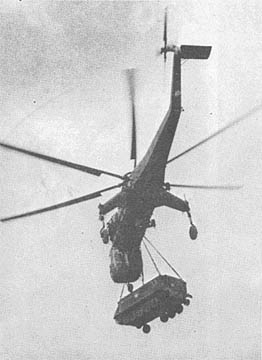 |
Luck is With LT
DAU TIENG - He was wearing a sock full of C-rations across his
chest, a bed roll high on his shoulders, and two canteens on his hips. The
VC opened fire from 15 feet away. They put a bullet through the bottom of
the lowest C-ration can, piercing all the others, and coming out of the top of
the last. Bullets pierced both his canteens. His bed roll was
shredded. His wounds: minor cuts on his chest and face from the exploding
C-ration cans.
The soldier was 1LT Henry Sterbenz of Glendale, N.Y., commander of
the 3rd Bn, 22nd Inf's Co. B, during the 3rd Bde, 4th Div's Operation
"Diamondhead."
The ambushers got away, but somewhere a Viet Cong is mumbling to
himself and shaking his head in wonder.
Sterbenz led his company back into Camp Rainier in the afternoon
rain.
2 Hoi Chanh, 2 Rifles Less
DUC PHO - There will be two less weapons shooting at the 1st
Bn,
35th Inf, because of two Hoi Chanh.
Recently the two former Viet Cong surrendered themselves to the Duc
Pho District Headquarters. They said they each had a weapon and were
willing to lead American troops to where the rifles were hidden.
With the assistance of an interpreter, the ralliers led Co A,
1/35th, directly to the cache. The infantrymen uncovered two MOS 36 bolt
action rifles.
|
Jewish Service |
'New Life' For Villagers
By SP4 Joe Carey
A new, curious and vital generation of Vietnamese is personified in
the form of Nguyen Van Trieu, the progressive village chief of Cao Phu, an Ap
Doi Moi (Real New Life Hamlet) 55 kms northwest of Saigon.
Most of the 3000 villagers of Cao Phu have been resettled from Viet
Cong dominated areas. They have attained the Ap Doi Moi status by scoring
higher than 70 per cent on the Revolutionary Development (RD) Team's "98
points." Other possible designations on the RD scale - Ap Binh Dinh, Ap
Tam Sinh, Ap Cung Co - indicate the villages have not yet reached their
potential.
The basic Ap Doi Moi qualifications are these: Elimination of Viet
Cong influence and corruption in both political and social status; establishment
of sound local government; provision for self defense; improvement of literacy
and sanitation; implementation of land reform along with development of
agriculture and handicraft industries; improvement of communication; and
recognition of deserving soldiers, public servants and citizens who have
participated in Revolutionary Development programs.
Trieu has worked closely for the past few months with CPT Edwin W.
Richardson Jr. of Perris, Calif., civil affairs officer for the 4th Bn, 9th Inf,
25th Inf Div.
Richardson feels they have come to trust and understand each other.
Over a late lunch in Go Dau Ha one afternoon they discussed various self-help
projects and the role Richardson might play in the increasing development of Cao
Phu.
By the time the table had been cleared, tentative plans for a
rabbit farm had been made, the Cao Phu library was a step closer to reality, and
the idea for a weekly newspaper had appeared. Richardson told Trieu,
through SGT Thanh the interpreter, that he was attempting to get textbooks for
the school.
Though Trieu is still a young man, he is fully aware of his
position and responsibility. The village chief is appointed by the Village
Administration Committee (VAC) the governing body of the village.
Enemy Trapped
DUC PHO - The night began like an ordinary night for the Recon
Plt.
of the 1st Bn 35th Inf.
Late in the night, two unsuspecting Viet Cong were spotted
moving toward the well-hidden ambush. Anxious moments passed until the
enemy was trapped. The infantrymen opened fire and instantly killed the
two guerrillas. A search of the area produced two pistols and several
documents.
| PASSWORD - SSG James Convoy, a 2nd Bn, 14th Inf squad leader examines a VC battalion commander's password book which was captured when his platoon overran a battalion command post. (Photo by SP4 Bill Wermine) | 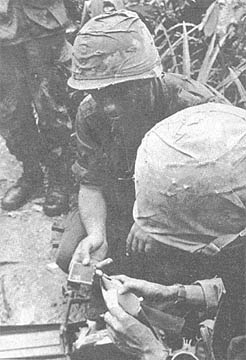 |
Page 4-5 TROPIC LIGHTNING NEWS Aug 14, 1967
Faces of Vietnam
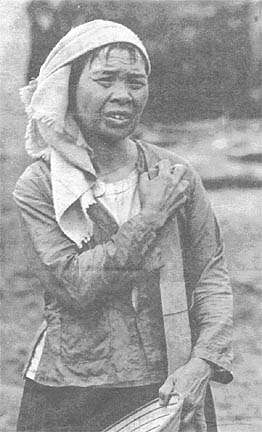 |
(Left)
Leaning against her crudely made hoe, this woman rests for
a moment before continuing her work. Her eyes have seen many soldiers come
and go. (Photo by 1LT Ralph Campbell) (Right, top) This girl has an irresistible smile. She isn't afraid - so far she doesn't know fear or terror - her eyes shine for the future. (Photo by 1LT Ralph Campbell) (Right, bottom) A puzzled expression of a young child who isn't sure what everything is all about. This photograph was taken at a MEDCAP in the village of Tha La. (Photo by SP4 Joe Carey) |
|
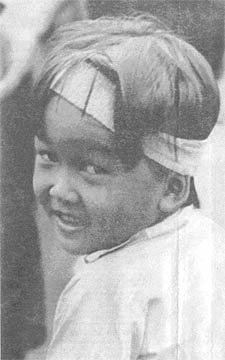 |
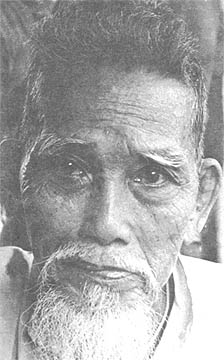 |
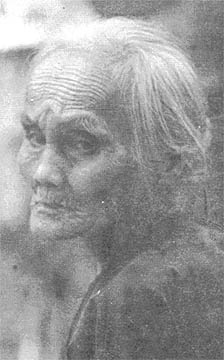 |
| The gleam can be seen in this boy's eyes as he is about to receive cake and ice cream. (Photo by UT Ralph Campbell) | This aging gentleman has seen more than his share of war and poverty. His eyes show neither fear, trust, nor distrust. Perhaps he waits to see what the future will bring. (Photo by SP4 Joe Carey) | An old woman whose eyes have seen many years of war looks distrustfully toward the camera. (Photo by 1LT Ralph Campbell) |
Page 6 TROPIC LIGHTNING NEWS Aug 14, 1967
Ambush Clicks, VC Die
In the night-blackened jungle outside Tan Phu Trung, the four men
of the ambush patrol were crouched and waiting; intelligence reports indicated
that VC would pass this way returning to their village where they would spend
the night with their families.
The VC appeared suddenly, moving silently through the jungle,
sometimes coming within inches of the concealed ambushers. At this time, a
cough, a sneeze, a slight movement by any member of the patrol would have meant
death for himself and his comrades.
Opened Fire
When the last VC had passed a few feet beyond their position, the
squad opened fire. Two VC were killed instantly and the others - at least
eight VC were involved - fled leaving a trail of blood behind them.
The patrol which routed the VC was composed of one American, one
ARVN and two Popular Forces soldiers.
Recalling how close he and his men were to the VC that night, SSG
Alfred Knopsnyder of Markleton, Pa., 2nd Bn, 14th Inf, says, "I couldn't
move my rifle for fear of bumping one of the guerrillas."
It's Effective
About the success of the patrol, the sergeant had this to say:
"In the dense vines, and bushes of the jungle, the only way for the enemy to
discover a concealed soldier is to directly stumble over one. That is why
the well-concealed and planned ambush is so effective."
School Built By Villagers
The villagers of Ap Mui Len in Quan Nghia Province are using the
material and technical assistance made available through the 25th Div's
Self-Help Program to build an addition to their school.
The school serves the rice-rich countryside just south of the
district seat of Cu Chi. The children presently attending classes range in
age from 6 to 12.
The structure, now about two-thirds finished, will double the
capacity of the school when completed. The teachers are anxiously awaiting the
finished product because of the overcrowded conditions in their classrooms.
To get the project off the ground, 1LT William Henderson of
Everett, Wash., civil affairs officer of the 25th Supply and Trans Bn, first
obtained the cooperation of the people in the hamlet. Then arrangements
providing for new teachers were made with the Provincial primary education chief
who is comparable to a superintendent of schools in the United States.
In the past, S-5 officers have had the problem of building schools
and then not being able to provide teachers. "This tended to irritate
rather than please the people," said Henderson. "That is why the
procurement of teachers is high on the priority list," he explained.
Henderson stated, "The materials are made available at little or
no cost, but the people must involve their own time and labor. By making
them provide that, they take more pride in the improvement and are less likely
to let it be abused by anyone, VC included."
Soldiers of the Month
SP4 Warren Lee Holton and SP4 Stanley J. Domian have been named
Soldiers of the Month for the 25th Supply and Trans Bn, for the months of June
and July, respectively.
The men were picked to represent their companies in battalion
competition on the basis of their past records and present performances.
Each was then chosen as Soldier of the Month on the basis of his performance
before a question and answer panel of Senior NCOs.
"Cacti" Kill 8
DUC PHO - A small breather hole in the side of a rice paddy dike
was the first sign "Charlie" was in the area. LT Homer Krout II,
platoon leader of the Recon Plt, 2nd Bn, 35th Inf, immediately established a
perimeter and began searching the area.
Conducting an early morning combat assault, the Recon Plt was
following an agent who said he could lead them to a tunnel complex.
Arriving at the location it appeared that the agent was mistaken.
"At first we couldn't find anything. Then one of my men saw the
breather hole,"
The Recon men began to enlarge the hole. Suddenly, four
grenades were hurled from the tunnel. Diving for cover, no one was
injured. The ensuing fight resulted in eight enemy killed and four weapons
captured.
Next, the Vietnamese agent reported that he knew where another
tunnel was located. "We arrived in the area but were unable to find a
tunnel," stated Krout. "We were ready to give up the hunt when the
Vietnamese agent became suspicious of a basket with bamboo shoots growing from
it. He moved the basket and revealed the entrance to a tunnel." A
search of the area revealed an empty tunnel.
As the choppers were coming in, two VC sprang from a spider hole
next to the LZ. Throwing grenades at the infantrymen they attempted to
escape across a rice paddy. Surprised, the infantrymen whirled around and
ended the escape attempt.
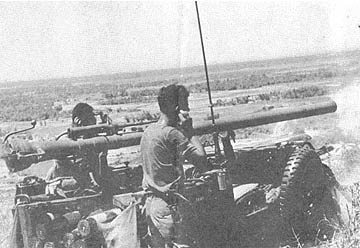 |
Duc Pho - A 106mm recoilless rifle, protecting LZ Liz, forward fire base of the 2nd Bn, 35th Inf. unleashes another round at a suspected enemy location on the coastal plain north of Duc Pho. (Photo by PFC Peter Daly) |
Booby-trap Factory Discovered
DUC PHO - Infantrymen of the "Tropic Lightning" 3rd
Bde,
conducting search and destroy operations southwest of Duc Pho captured what was
believed to be a small booby trap factory.
The VC working in the small shop were evidently surprised by the
U.S. soldiers and abandoned the area and their equipment to avoid contact.
The "Cacti" of the 1st Bn, 35th Inf, were searching an area of
constant enemy activity when a concealed trail leading into heavy underbrush was
located. LT Roger G. Ladd, the platoon leader, ordered his men to search
along the trail. The infantrymen did not go far when they found a small
"hootch" and the necessary equipment to construct booby traps and grenades.
The find included fuses for grenades, a container full of small pieces of metal
to be used as shrapnel, gun powder, commo wire and 18 rounds of .30 cal. ammo.
Also found were parts of weapons, two tons of rice, documents and
maps, and a sight for an anti-aircraft weapon.
Although the enemy had fled the area, the confiscation of the bobby
trap material may well be more important.
Booby traps, planted with devious ingenuity, have plagued the
infantrymen since arriving in Duc Pho.
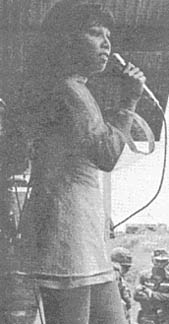 |
SWINGING SINGER - Mini-skirted Miss Jerry Woo entertains the troops of the 3d Bde, 4th Inf Div during a performance of the Jack Costanga Show. Playing a variety of Latin tunes, the group played to over 2000 men in the Rice Bowl at Tay Ninh. (Photo by SIPS George Swengros) |
Collectors Captured
A 70-year-old Vietnamese farmer, tired of being taxed by local Viet
Cong, led a U.S. Infantry patrol to five tax collectors.
The patrol, from the 4th Bn, 9th Inf, were in a daylight ambush
position eight kms northwest of the 25th Inf Div's base camp at Cu Chi, when
the sound of someone sloshing through a rice paddy alerted them.
An old man was spotted approaching the ambush site, and as he
neared, one of the men stepped out and halted the farmer.
As the squad neared a rice paddy, they were spotted by five VC.
Two of the enemy took off running - the infantrymen were unable to shoot because
of the farmers working in the surrounding paddies, and they escaped. They
did succeed in capturing the other three.
Although they got three prisoners, the two that got away were
carrying all the money.
Page 7 TROPIC LIGHTNING NEWS Aug 14, 1967
Cu Chi Computer is VN first
By MSG Jack Maguire
History was made recently when MG John C. F. Tillson III, announced
that the division's artillery units were chosen as the first units engaged in
combat to be equipped with the Field Artillery Digital Automatic Computer (FADAC).
"I share with my men the pride of being first," COL David E.
Ott, 25th Div Arty commander, stated upon hearing the news.
The outstanding feature of the computer is that it automates all
fire direction computations, allowing computations for a mission that take about
two minutes by the present manual method to be made in twenty seconds with
extreme accuracy.
FADAC's versatility is apparent in its ability to allow one
computer to control five batteries or fire units, firing multiple missions with
two different weapons such as 105mm and 155mm pieces and from memory, furnish
information for first round target hits without registration.
All firing batteries and battalion headquarters will be issued
FADAC immediately. The cost to equip these units is the same as paying for
36 armored personnel carriers (APC). It is considered well worth it by the
artillery men.
Also in another historical event at the 25th Inf Div's Cu Chi
base camp, COL Ott pulled the lanyard on one of Btry D, 3rd Bn, 13th Arty's, 8
inch guns, firing, as he had earlier stated, "the first round fired in anger
at an enemy, using data supplied by FADAC."
The mission was harassment and interdiction with the target a trail
junction known to be well used by the enemy. Every one present for the
firing and demonstration was amazed at the speed and accuracy of FADAC in
furnishing adjustment information.
"It completely revolutionizes fire direction procedures," CPT
Curtis L. Lamm, commander, Btry D, 3/13 Arty, said as he viewed the computer in
operation.
The computer is powered by a practically weatherproof gasoline
generator that even withstands monsoon rain torrents. Two generators are
issued to insure continuous operation.
Battalion maintenance personnel get two pieces of equipment for
periodic testing of the FADAC's to keep them in tip-top working condition.
These are the signal data reproducer, which is also the computer's memory
loader, and the computer logic unit test set. These machines can determine
the very smallest adjustment that may be necessary to keep a FADAC operating
perfectly.
| ACCURACY AND SPEED - SFC Daniel H. P. Stanley, instructor, Field Data Systems, Ft. Belvoir, Va., makes history at Cu Chi base camp as he operates the Field Artillery Digital Automatic Computer (FADAC). The computer adds greatly to the accuracy and speed of fire direction methods. The 25th Div Arty fired this historic mission. (Photo by PFC Henry Trice) | 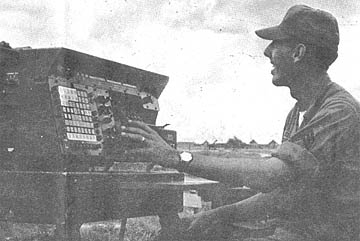 |
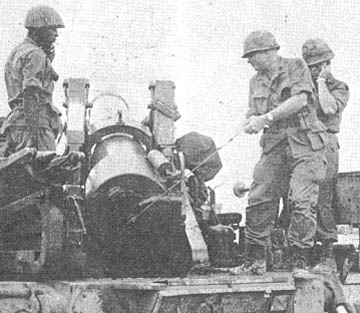 |
HISTORY ON THE WAY - COL David E. Ott, commander, 25th Div Arty, pulls the "lanyard on an 8-inch gun firing the first round at the enemy using data supplied by the Field Artillery Digital Automatic Computer (FADAC). The mission was fired by Btry D, 3rd Bn, 13th Arty. Looking on is SSG William J. Holley (left) and PFC David C. Wills. (Photo by PFC Patterson) |
| FIRE MISSION - One of Btry D, 3rd Bn, 13th Arty, 25th Div Arty's, 8-inch guns makes history as it fires a mission using data supplied by the Field Artillery Digital Automatic Computer for the first time in a combat zone. (Photo by PFC Patterson) | 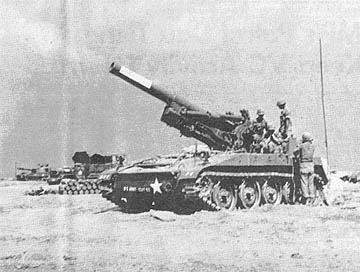 |
Page 8 TROPIC LIGHTNING NEWS Aug 14, 1967
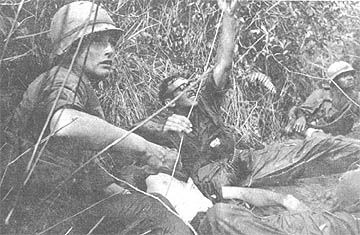 |
FACE OF COMBAT - Anxiety on their faces, Infantrymen of the 1st Bn, 27th Inf, watch for the helicopter that will evacuate their two wounded buddies, after the squad was hit by automatic weapons fire from an enemy position. The battalion was on a 25th Inf Div operation 26 kms west of Saigon. (Photo by SP4 Joe Carey) |
Young Girl Sends Flags To 25th Div
A little girl with two brothers in the military service took to the
streets selling dandelions in Manchester, N.H., recently so she could buy
American flags to send to troops in Vietnam.
Nancy Ann Hobbs, 7, had received a letter from her brother in the
Marine Corps stating he would like a U.S. flag for his unit. Nancy's
efforts in trying to raise money for a flag received a lot of local publicity
and she eventually had donations totalling $25.
A local Army recruiter who had enlisted one of Nancy's brothers
in the Army suggested that the flags be sent to the 25th Inf Div, his former
unit.
The suggestion was adopted and the small U.S. flags are presently
being distributed throughout the command.
MP's Patrol Dau Tieng, Keep VC Activity Down
DAU TIENG - By nine o'clock in the evening, the streets of Dau
Tieng are deserted. Light flickers from the little huts and houses that
line the hard-packed dirt streets. Occasionally, a dog goes running after
some of the chickens who are still scratching at the ground for an occasional
snack. If a person has to leave his house at night, he must carry a
lantern - not a flashlight.
At ten, eight men are ready to go. They carry only their
weapons - grenade launchers, M-16's and 45's, ammunition, and instead of the
steel pot, they wear soft caps. It is a small, professional squad carrying
just the essentials for a patrol - well-armed but not slowed by too much
equipment. There is a dog with them - highly sensitive and alert. If
action comes, they will be ready.
To those of us in Vietnam, the squad described above has all the
earmarks of a Long Range Reconnaissance Patrol.
Long hours of training and experience mold the patrol into a single
unit. However, the soldiers above are not members of a LLRP, in fact, they
are not even infantrymen - they are a squad from the Military Police Platoon
stationed with the 3rd Bde, 25th Div, in Dau Tieng.
Their mission, however, is similar to that of the long range
patrol.
Each night, a squad of Military Police moves from Camp Rainier into
the village of Dau Tieng on a town patrol. After checking the positions of
the ambush patrols which are set each night by the brigade and also by the
Popular Forces in the village, the squad moves through the town, alert for Viet
Cong activity, curfew violations, or the occasional soldier who has decided to
slip through the wire of the camp and go into the off-limits village. On
most occasions, the MP's are accompanied by Popular Force troops from the
district outpost.
Dau Tieng at night is still far from being a safe place for a
little stroll, but the town patrol helps to make it a little safer than before.
| The 25th Infantry Division Information Office is presently compiling material and photographs of all division activities from 1 October 1966-1 October 1967. Anyone having good color, black and white, or color slide photographs of combat, civic action, or any other division activities, please bring them to the PIO and give them to LT Rottmann or PFC Hairston. If you desire, the photos will be returned, unharmed, after they are copied. Also any interesting sketches in pencil, ink, or water color can be used. |
Bamboo Probe
A sharpened bamboo pole has become standard equipment for men of
the 1st Bn (Mech), 5th Inf, and the results have been enough to make a VC supply
expert cringe.
The Viet Cong frequently hide ammunition and weapons in containers
sunken into the mud along the Oriental River, northwest of Saigon. The
25th unit makes use of needle sharp bamboo poles to probe for the material.
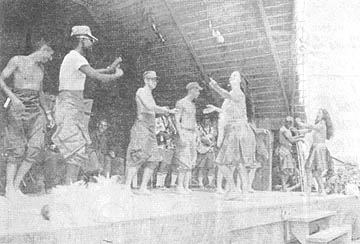 |
SHAKE IT - Recruited from the audience, these embarrassed soldiers try the Hula at the 25th Div.s Lightning Bowl. Action took place during the USO show "Aloha From Hawaii". (Photo by SP4 Clifton Cordell) |
Thanks to
Gary Hartt, 2nd Bn., 22nd Inf. for sharing this issue,
Kirk Ramsey, 2nd Bn., 14th Inf. for creating this page.
This page last modified 8-12-2004
©2004 25th Infantry Division Association. All rights reserved.